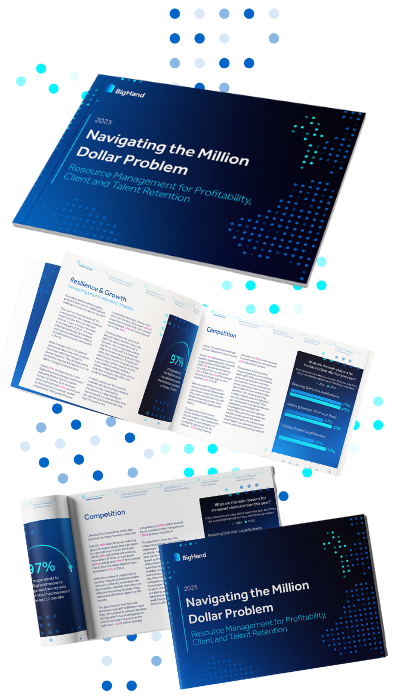Let’s rewrite the underdog narrative
Mid-sized law firms often play the role of the underdog, often outpaced by the marketing muscle of global players. But things are changing. In a legal world where clients demand more for less, and lawyers are increasingly questioning where and how they work, mid-sized law firm competitiveness now partly hinges on a firm’s ability to manage its people and employee workloads as strategically as it manages its profits.
The latest report from BigHand, Navigating the Million Dollar Problem, lays bare the challenges facing firms today - from high attrition rates to lack of visibility over who’s doing what, and when. The good news? Mid-law has a golden opportunity to level the playing field.
Let’s look at five ways mid-sized firms can compete with Big Law in the war for legal talent and come out more profitable in the process.
1. Attract and retain top talent (obviously)
When you’re a large law firm operating with 3,000 plus lawyers, losing a handful won’t rock the boat too much (unless they take others with them, of course!). But if your team is closer to 100 lawyers, even small waves can hit like tsunamis. In fact, 49% of mid-sized firms report rising recruitment and training costs from attrition, and 45% say the pressure on remaining staff is pushing burnout risk higher.
As such, we’re seeing talented, well-trained lawyers reassessing their career paths. Many are seeking more meaningful work, fairer treatment, and better balance, whether that’s remaining within practice or looking to move in-house. This is a big opportunity for mid-sized firms to position themselves as an appealing alternative to the Big Law experience, without necessarily competing against their remuneration offerings.
By adopting a smarter approach to legal resource management, firms can show potential recruits that they'll be seen and heard. When I engage with lawyers, they often tell me they want to see clear pathways to purposeful work and exposure to high-quality clients. Genuine career development paired with balanced workloads makes a compelling pitch, and firms that have implemented a plan of legal resource management are making a point of it within interviews. Lawyers are also less inclined to move from one firm where it exists to another where it hasn’t been thought about.
2. Stop playing favourites
42% of mid-sized firms say partners still assign work based on personal preference. Aside from the operational inefficiency aspect, that’s just demotivating for lawyers particularly new joiners. This kind of legal resourcing bias leads to uneven development opportunities, poor morale, and - you guessed it - more attrition. Switching to informed work allocation with increased data visibility removes guesswork (and favouritism) from the equation. With better visibility of skills, experience, relationships, and availability, you can assign the right person to the right job at the right time.
3. Free lawyers from admin
When lawyers spend three to four hours a week on internal admin, as 30% of law firm leaders report, it’s frustrating and costly. For what it’s worth, I reckon this statistic is much higher in practice (see next point about visibility).
This is time that could be spent on client work, mentoring juniors, or developing new business. These inefficiencies are a hidden cost that few firms account for in their budgets.
Smart firms are using tools for lawyer workload planning to eliminate the admin burden, improve workflows, and refocus fee earners on what they do best. It’s a direct route to improving law firm profitability without raising billable targets.
4. Use visibility as your secret weapon
Here’s a worrying stat: only 49% of firms have full data on future capacity and utilisation, and only 45% understand the full skillsets of their fee earners. For mid-law, where every headcount really matters, that lack of clarity has a direct impact on efficiency, client delivery, and morale.
By improving visibility into who’s available via easily done forecasting, who’s good at what, and where interests lie, and how busy they are, firms can make smarter decisions and considerably faster. This is key to addressing lawyer utilisation rates, improving matter margins, and advancing law firm workforce planning to meet law firm profitability challenges.
5. Make profitability part of your culture
Many firms still treat profitability as something to be reviewed in retrospect. But when you’re allocating work in a way that ignores margins, you’re leaving money - and value - on the table. The report shows 41% of mid-law firms don’t factor profitability into how they resource matters. That’s a missed opportunity.
By integrating resourcing with matter economics, firms can ensure work is handled by the right level of resource, at the right cost. That’s what turns profitability from a spreadsheet column into a daily decision-making lens - a core driver of legal operations efficiency.








